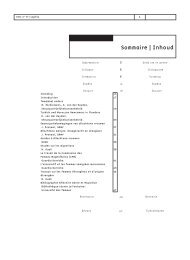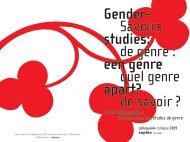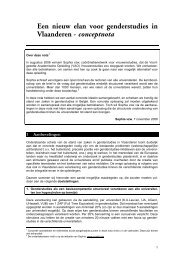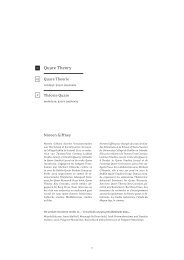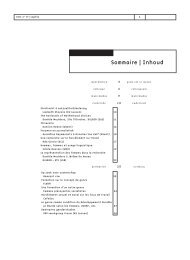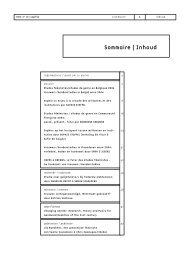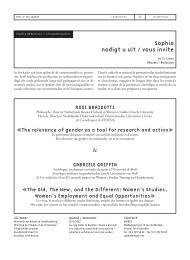Nieuwsbrief 32 (pdf) - Sophia
Nieuwsbrief 32 (pdf) - Sophia
Nieuwsbrief 32 (pdf) - Sophia
You also want an ePaper? Increase the reach of your titles
YUMPU automatically turns print PDFs into web optimized ePapers that Google loves.
echerche<br />
34<br />
onderzoek<br />
sophia | n° <strong>32</strong> | 2002<br />
other leave arrangements. The research<br />
analysing data on the United Kingdom<br />
and the United States includes also the<br />
effect of women being concentrated in<br />
part time jobs which appear to be paid less<br />
in the United Kingdom and the United<br />
States. Sweden and Denmark have not<br />
included part time work as an explanation<br />
for differences in pay between mothers<br />
and childless women. The studies reviewed<br />
are unclear about what part of the<br />
child penalty is explained by accumulated<br />
years of employment experience.<br />
Fertility and women’s work status is the<br />
central topic of the fifth chapter. During<br />
the last two decades, fertility rates have<br />
sharply decreased in most developed<br />
countries, childbearing has been delayed<br />
and the correlation between fertility and<br />
participation rates across the European<br />
countries has become positive. The flexibility<br />
of the market to accommodate<br />
women’s exit and entry decisions and the<br />
reduction of the penalty induced by career<br />
breaks, like foregone experience, delayed<br />
wage growth and increased risk of unemployment,<br />
are aspects that can explain<br />
those trends. Both changes in fertility<br />
and changes in employment are related to<br />
an increased emphasis on individual independence<br />
and to the desire of women to<br />
be attached in a more permanent way to<br />
the labour market (Lesthaeghe, and<br />
Willems 1999)(6).<br />
The authors distinguished different equilibriums<br />
across EU countries. In Northern<br />
Europe, both large public sectors<br />
with a large share of female workers and<br />
generous maternity benefits guarantee a<br />
high level of female participation and a<br />
high fertility rate (still barely below replacement<br />
rate). In Southern Europe, in<br />
which female participation is relatively<br />
low, part time is uncommon and the stickiness<br />
of unemployment has brought<br />
about a dual market with unstable labour<br />
contracts for young workers. Fertility is<br />
relatively low.<br />
Other factors were also analysed such as<br />
education, child care, part time, and coresidence<br />
with adult children.<br />
The sixth and last chapter of our State of<br />
the Art provides some insight into the<br />
question of how motherhood influences<br />
time allocation. Nowadays, in order to<br />
understand differences among peoples’<br />
allocation of time in different countries<br />
it is necessary to take into consideration<br />
many variables such as men’s and women’s<br />
access to paid work and their economic<br />
independence, or the complex relationship<br />
between work, household duties<br />
and welfare provision.<br />
It seems quite difficult to detect the<br />
influence of policy measures on the actual<br />
behaviour of men and women, especially<br />
with regard to work, childcare and housekeeping.<br />
The more women have to give<br />
up earnings in order to reconcile family<br />
and working life (or, the more domestic<br />
work is time-consuming), the more they<br />
are inclined to leave their labour market<br />
position and give up their independent<br />
income. Quite often, taking care of children<br />
or elderly family members determines<br />
the position of women in the<br />
labour market and their family size.<br />
Current legislation on equality between<br />
men and women is quite progressive in<br />
European countries, and the question of<br />
equality has been widely debated in the<br />
last decades. Nevertheless, the prevailing<br />
norms and values are not in line with the<br />
relevant legislation.<br />
An individual and non-transferable right<br />
to a partly paid paternal leave is a good<br />
example of the kind of measures that<br />
should be implemented. Other forms of<br />
intervention should combine financial<br />
support for beneficiaries and careers with<br />
services in kind, without undermining<br />
the structure of family life. Think of<br />
‘home help’ and ‘care at home’, for example.<br />
Organised voluntarism could also<br />
play an important role and existing informal<br />
networks should be reinforced.<br />
Exploration of new forms of interaction<br />
between the ‘public’ and the ‘private’ is<br />
needed.<br />
Contact<br />
Danièle Meulders, Department of Applied<br />
Economics, Free University of Brussels<br />
Av. F.D. Roosevelt 50, 1050 Brussels, Belgium<br />
Tel +<strong>32</strong> 02 650 41 12<br />
Fax +<strong>32</strong> 02 650 38 25<br />
dmeulder@ulb.ac.be<br />
Síle O’Dorchai, Department of Applied<br />
Economics, Free University of Brussels<br />
Av. F.D. Roosevelt 50, 1050 Brussels, Belgium<br />
Tel +<strong>32</strong> 02 650 42 55<br />
Fax +<strong>32</strong> 02 650 38 25<br />
sile.odorchai@ulb.ac.be<br />
Notes<br />
1 LUMEN, J., LE CACHEUX, Jacques, MEUL-<br />
DERS, D. (2000) Policy Digest.<br />
2 ADEMA, Willem; EINERHAND, Marcel;<br />
EKLIND, Bengt; LOTZ, Jorgen; PEARSON,<br />
Mark. (1996) Net public social expenditure.<br />
OECD, Paris, Labour market and social policy<br />
occasional papers n°39, 1996.<br />
3 ESPING-ANDERSEN, G. (1990) The Three<br />
Worlds of Welfare Capitalism. Cambridge, Polity<br />
Press, 1990<br />
4 PFAU-EFFINGER, B. (2000) Changing Welfare<br />
States and Labour Markets in the Context of<br />
European Gender Arrangements. Centre for<br />
Comparative Welfare State Studies, Aalborg<br />
University, Denmark, COST A13 Action<br />
“Changing Labour Markets, Welfare Policies<br />
and Citizenship”, Gender Group Working<br />
Paper, 2000.<br />
(http://www.socsci.auc.dk/cost/gender/workingpapers.html)<br />
5 Datta Gupta Nabanita and Nina Smith 2000<br />
Children and Career interruptions: The Family<br />
Gap in Denmark, CLS working paper<br />
2000:18, University of Aarhus and Aarhus<br />
School of Business.<br />
6 Lesthaeghe, R., and Willems, P., (1999), “Is Low<br />
fertility a Temporary Phenomenon in the Euro-




